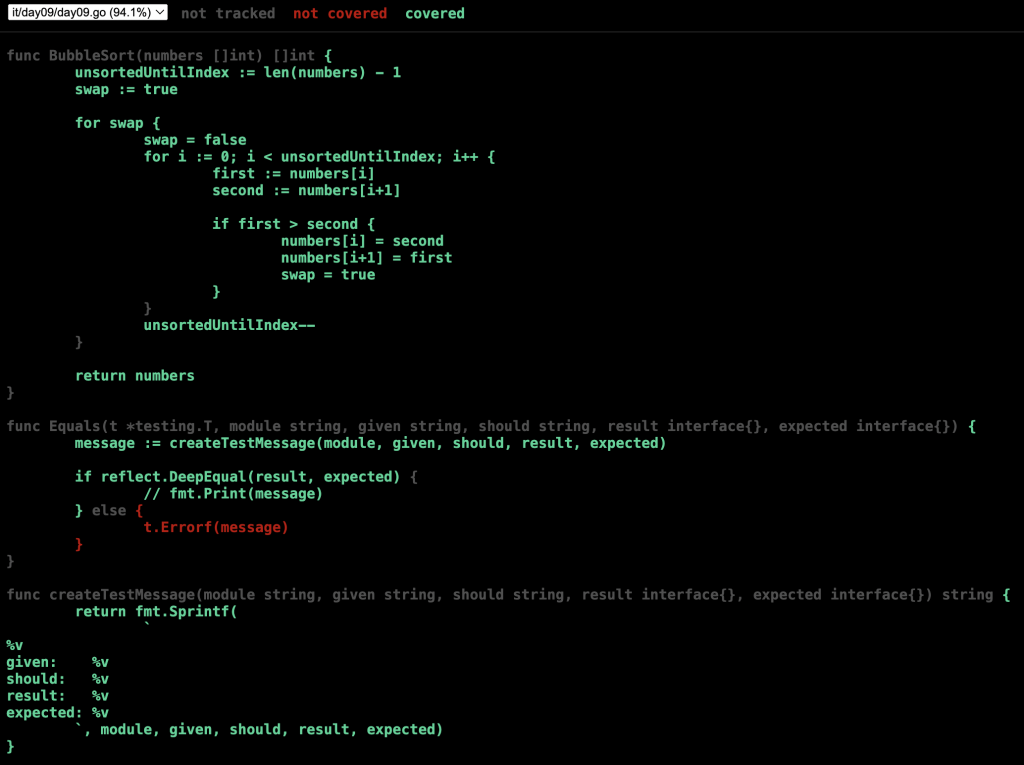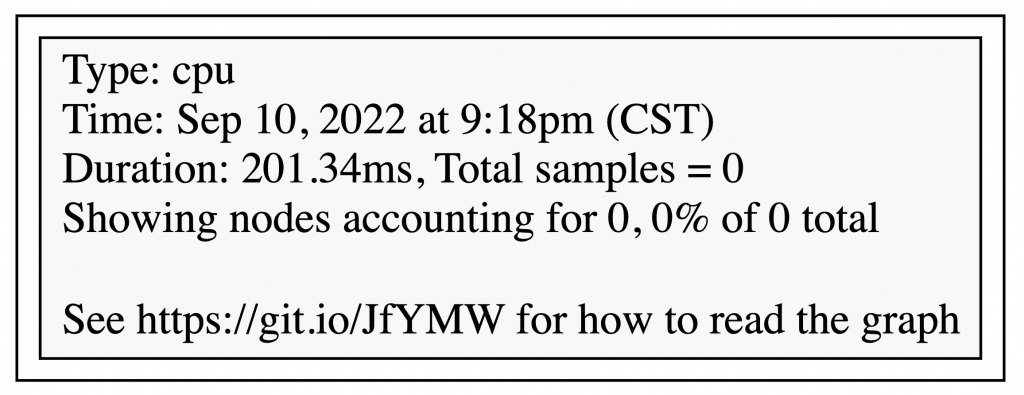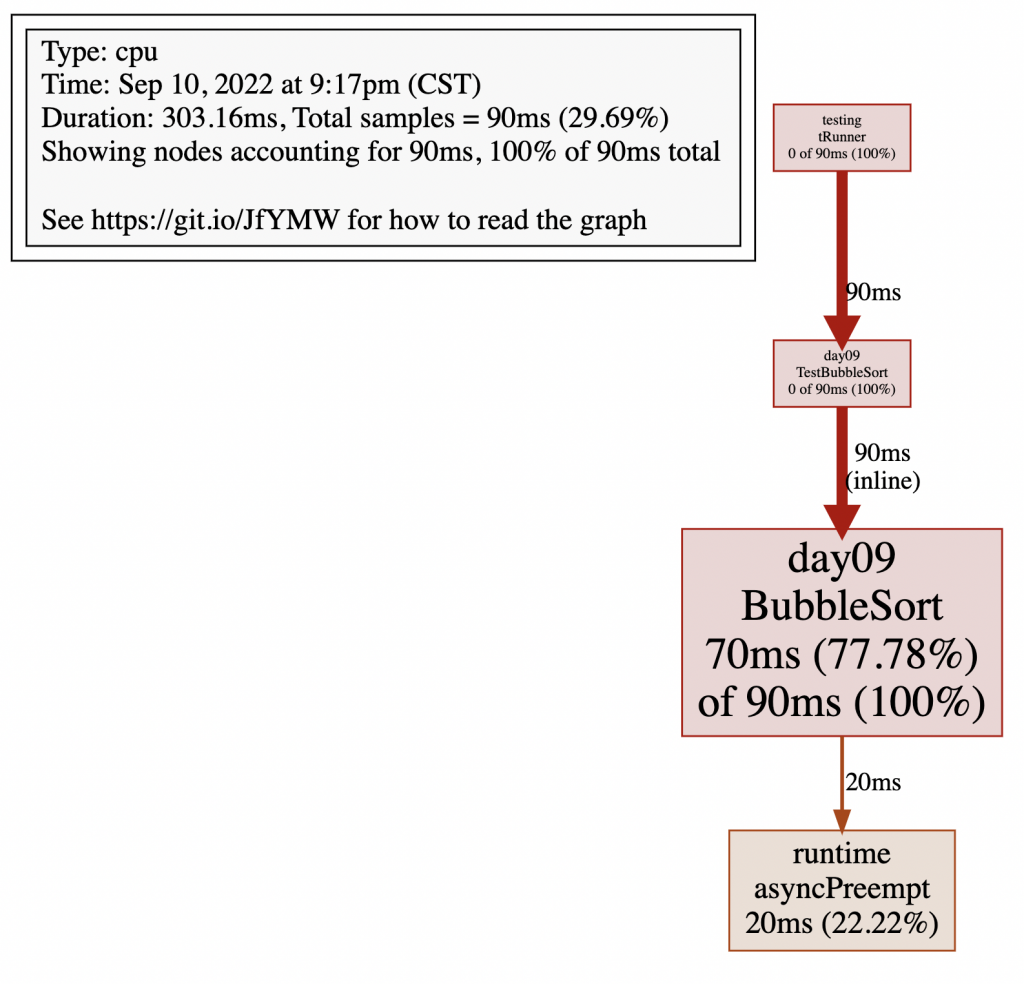上一篇我們提到單元測試,但除了檢查程式碼的正確率以外,還無法看出單元測試的重要性與強大,但前面有提到單元測試除了函數的正確性,此外也能看出函數的效能,因此這篇主要針對單元測試的效能,用上一篇 day09 的程式碼為例子
func BubbleSort(numbers []int) []int {
unsortedUntilIndex := len(numbers) - 1
swap := true
for swap {
swap = false
for i := 0; i < unsortedUntilIndex; i++ {
first := numbers[i]
second := numbers[i+1]
if first > second {
numbers[i] = second
numbers[i+1] = first
swap = true
}
}
unsortedUntilIndex--
}
return numbers
}
func Equals(t *testing.T, module string, given string, should string, result interface{}, expected interface{}) {
message := createTestMessage(module, given, should, result, expected)
if reflect.DeepEqual(result, expected) {
// fmt.Print(message)
} else {
t.Errorf(message)
}
}
// 自定義輸出格式
func createTestMessage(module string, given string, should string, result interface{}, expected interface{}) string {
return fmt.Sprintf(`
%v
given: %v
should: %v
result: %v
expected: %v
`, module, given, should, result, expected)
}
// 單元測試,命名方式請遵守上面的6個規則,表格驅動測試
func TestBubbleSort(t *testing.T) {
tests := []struct {
input []int
expected []int
}{
{[]int{4, 2, 7, 1, 3}, []int{1, 2, 3, 4, 7}},
{[]int{10, 9, 8, 7, 6, 5, 4, 3, 2, 1}, []int{1, 2, 3, 4, 5, 6, 7, 8, 9, 10}},
}
for _, test := range tests {
result := BubbleSort(test.input)
Equals(t, "BubbleSort()", "Given slice of integers", "Should return slice sorted in ascending order", result, test.expected)
}
}
如果想要查看代碼覆蓋率(代碼覆蓋是軟體測試中的一種度量,描述程式中原始碼被測試的比例和程度,所得比例稱為代碼覆蓋率),可以再相對應的路徑下在終端機中輸入以下指令:
go test -coverprofile=c.out
go tool cover -html=c.out
就可以看到以下畫面:

如果想要看 cpu 的使用情況,那麼可以透過以下指令,但是必須先安裝 Graphviz ,可在官網下載:
go test -bench . -cpuprofile cpu.out
go tool pprof cpu.out
(pprof) web
那結果如下:

可以看到,上面什麼也看不出來,因為測試的情境太簡單,所以基本上消耗不到什麼 cpu,因此在測試的地方 func TestBubbleSort 我稍微改了一下我們的表格驅動測試,先聲明,這只是為了展示,理論上後面的答案應該要輸入已知的正確資訊
func TestBubbleSort(t *testing.T) {
input := make([]int, 10000)
for i := 0; i < 10000; i++ {
input[i] = rand.Intn(10000)
}
tests := []struct {
input []int
expected []int
}{
// {[]int{4, 2, 7, 1, 3}, []int{1, 2, 3, 4, 7}},
// {[]int{10, 9, 8, 7, 6, 5, 4, 3, 2, 1}, []int{1, 2, 3, 4, 5, 6, 7, 8, 9, 10}},
// 只為了展示,所以解答直接透過函數運算
{input, BubbleSort(input)},
}
for _, test := range tests {
result := BubbleSort(test.input)
Equals(t, "BubbleSort()", "Given slice of integers", "Should return slice sorted in ascending order", result, test.expected)
}
}
那就可以看到以下結果,總共耗時90ms,其中在執行 BubbleSort 的中佔了70ms,也可以透過這種方式知道究竟在執行程式時,哪些程式會佔用特別多的時間,那這些區域也是未來主要可以優化的區域

https://github.com/luckyuho/ithome30-golang/tree/main/day10
